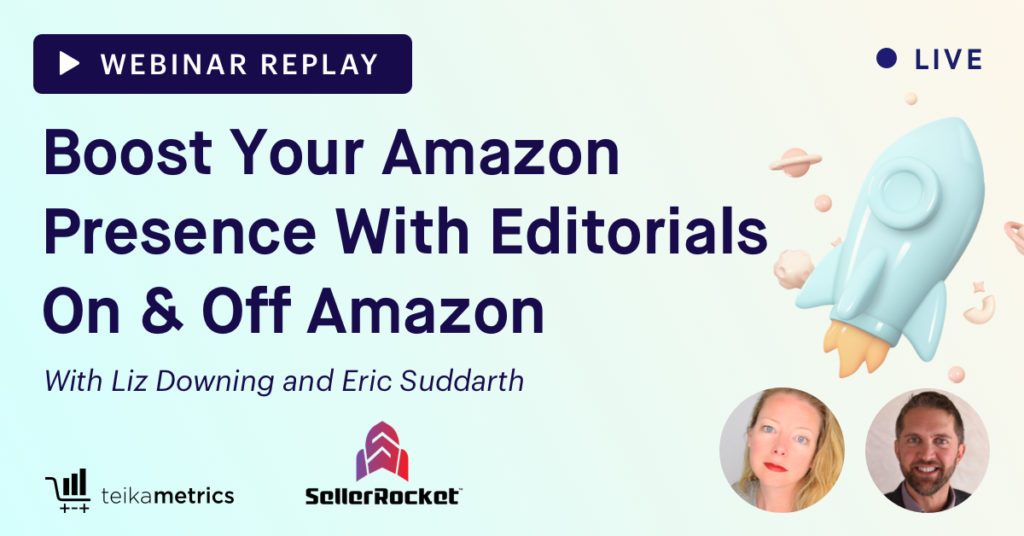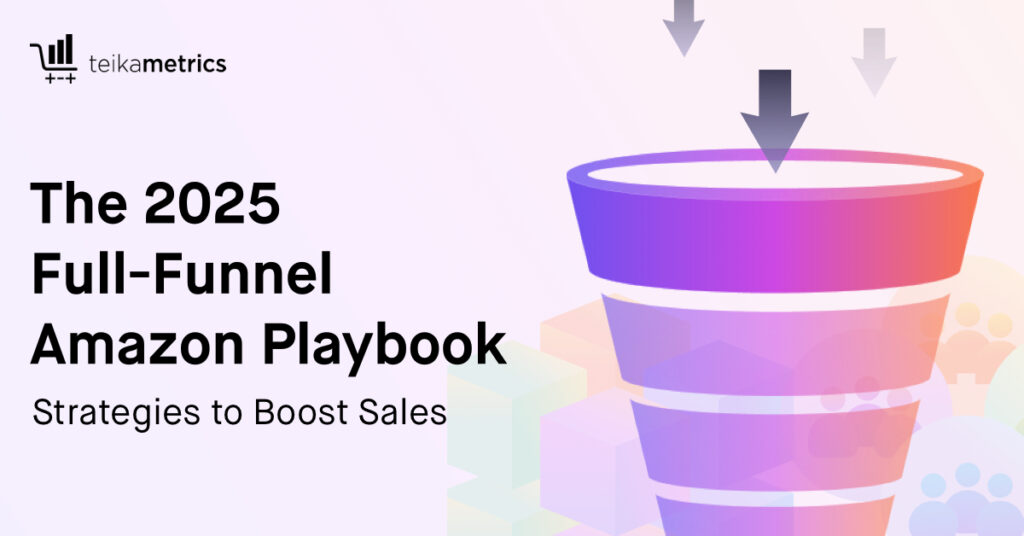Amazon sellers know the importance of reviews and good ratings when it comes to converting on Amazon. But once you have those in place, there’s another tool that can boost your sales even further: editorials. Editorials get your products on page one of search results, build consumer trust, and drive traffic to your product listing. When a well-renowned publisher recommends your product, it puts added weight behind those reviews and high ratings and increases conversions. Eric Suddarth, general manager of Seller Rocket, works to pair brands with publishers in the Amazon publisher affiliate program. In this webinar, he explains how it works and how to get the most from it.
Webinar Takeaways
- Build customer trust with editorials
- How Amazon uses editorials
- Established products do best for onsite Amazon editorial
- What to do with multiple ASINs and keywords
- Amazon provides limited data for onsite editorials
- Commissions are low, but can add up
- The value is in the publisher relationships
- See where you are with current editorials before pursuing more
- Match with high ranking offsite content
- Share your editorials widely
Show Links
- Check out Seller Rocket
- Connect with Eric Suddarth on LinkedIn
- Check out Teikametrics
- Connect with Teikametrics on Twitter or LinkedIn
Watch The Full Replay
Key Teikaways
03:33 – Build customer trust with editorials
Seller Rocket has relationships with publishers in Amazon’s publisher affiliate program. If a client product is chosen by one of these publishers to include in an editorial, it will be featured in content on page one of the search results.
“We take brands that we recommend to these publishers and we say, I am working now with a laundry detergent brand. Here’s this product. Would you be interested in writing about that brand? And so a lot of times the publishers may have already existing articles. So say this Everyday Health article already existed, and they have some products in there, we may be able to bring another product to them to say, Hey, would you be wanting to write about this brand? And they can put it in the article, or if they don’t have articles about it, they could write new content about it. And so the way that this helps a brand to grow is not only is this increasing brand awareness on page one of search, but also this can put additional trust behind your brand name. So there are other really well-known publishers in this program, like Good Housekeeping for instance. So if I’m selling a throw pillow and now it’s in an article recommended by Good Housekeeping, it can really put some additional trust behind your brand and somebody could think, well, Hey, maybe I should check this out. Because this is recommended by this highly renowned publisher.”
07:27 – How Amazon uses editorials
Amazon uses these editorials on the result pages for related keywords, but there are a variety of things that impact where and when they show up.
“Amazon does a lot of different things with these editorials. So they will show different editorials to different folks based on your search history. We also think – Amazon doesn’t publicize any of this – but we think there are other things that impact how often editorials render and who they render for. Some of those things would include the sales velocity of the products within the article, a click history for products within the article. We also know that your search history likely plays a role in that. So Amazon is going to show whatever it thinks is most likely to make you make a purchase. And something I’ll show a little bit later that they’ve done more recently, that is something we think that they’re testing. In the past, the articles would show up like this, where there’s one article, you see three products featured. And if I click to the right arrow, then I would see more products. But one thing that Amazon has been doing more recently, they’ve actually put a number of articles about that product category below.”
12:03 – Established products do best for onsite Amazon editorial
Seller Rocket only works with established products for Amazon editorials because of the review process Amazon uses. But offsite editorials could be used for new products.
“Seller Rocket uses guidance, we look for four stars and at least a hundred reviews. We do this because of a couple of things. One, we want to make sure that it’s not a brand new product that doesn’t have any reviews and potentially could be something that a publisher or Amazon will reject. So the publisher is going to write the content, curate it, and they’ll push it through their approval process, but eventually the very last step in this process is it goes to Amazon for moderation approval. And so Amazon has a team that sits in India that does all of this moderation content approval. And we want to make sure that if the article makes it through all the steps and gets to that team, that it’s not rejected for something that could have been handled sooner. Because usually the steps in the process are pretty quick until that Amazon moderation step. And that could take two days, it could take three weeks. It’s not something that we have any input or control over.”
16:34 – What to do with multiple ASINs and keywords
Some brands have several related products or several keywords for one product. Only one product per brand and keyword will ultimately be used for an editorial.
“There was a brand or a company that sold a number of different dog products. And they had seven different types of dog leashes and they were all technically different ASINs. They weren’t all of the same parent ASIN, but they were different styles, but they wanted us to try to work with a publisher to get all three of the primary spots in an on-site Amazon editorial for their products and publishers are wary of that. They just don’t want the article to make it look like it’s an ad. But if for instance, Jerry had – this is something other people will say – they’ll say, Hey, I have this ASIN, but I have three keywords for this ASIN that I really want to make sure are represented for my ASIN. And how can you help me with this? So what we would do there, first we would work with the publisher and make sure – we can submit up to three keywords for that ASIN to the publisher – and we make sure that all three of those keywords were either ranking on the first page organically, or top half of the second page. And so we would do that mainly because we want to make sure the publisher is interested in and sees there could be good sales velocity for this product if I was to use it. But then the publisher will select one keyword to send over to Amazon and then Amazon will actually select the keyword that makes the editorial render.”
18:23 – Amazon provides limited data for onsite editorials
The editorials are different from an ad. There is not much data that you can analyze to measure their performance.
“This is where it’s very different than a PPC ad where I know exactly what keyword I’ve bid on, how much I paid for it. I have all these statistics about clicks and just a lot of data that a great client partner like Teika could help with to provide a lot of data about my PPC campaign. This is very different than that. So the only pieces of data that we’re able to provide back for the on Amazon editorials. We will get data from Amazon via the publishers on the number of attributable transactions that came from these editorials, but we don’t get clicks or impressions. So we don’t know how many times the editorial rendered. We are working on a tool with a new partner that would give more data about share of voice and so how often certain keywords may be editorial render. This is in more of a beta phase right now. So we’re hoping this is something that we can publicize and share very soon. But to this point the only data that we’re very confident about are the attributable transactions for the on Amazon content. For off of Amazon editorial content that I haven’t talked about yet, we do get more data from our publisher partners.”
20:23 – Commissions are low, but can add up
Publishers don’t make a lot per conversion, but when a product does really well, those small affiliate commissions can add up and show the power of editorial placement.
“The affiliate commissions are not, they’re not huge numbers. I think for the on-Amazon editorial content, our estimate is around 1%. And then off of Amazon, it’s a little higher, maybe two to four, but these are not really big numbers. With some of the clients we work with we saw some amazing GMV generated. One client for instance, they sell an electronics product. It in November alone generated more than $400,000 in GMV in gross merchandise value for off of Amazon editorial content for one ASIN. Now they did run some deals and this was an item that they were really pushing on for Black Friday. When we were able to present that data back to the client and say, Hey, look. Cause in the past, a lot of clients would see editorial attribution as like a black hole. They didn’t really know what is this doing for me? Is this causing conversions? Does this do anything for my brand? And we were able to show that to them and show, here are all the transactions that were attributed back to these editorials. Was super powerful.”
22:54 – The value is in the publisher relationships
Seller Rocket is strict about guidelines because their value comes from the publishing relationships that are built in and risky products could affect those relationships.
“If we have a brand that has 98 reviews and 4.7 stars, we’re not going to decline it. If they’re close to 100 reviews, we’ll usually say that’s okay. But if they have five reviews and three stars, we’re just not going to push that forward. Cause the value proposition that Seller Rocket brings to its clients comes from our relationships with our publishers. And we want to protect those relationships because there’s no secret sauce in our business model. Somebody could try to replicate our model tomorrow, but the real value that we bring is we have all these relationships already. And sellers will come to us and say, I’ve reached out to a hundred publishers. I never got a response. I sent free product samples. I wasted all this money and I didn’t get anywhere, but I still want to try to get into this content. Can you help me? And we’re able to help them way faster and for a much smaller amount of money than they were spending by sending free product samples out and not getting anywhere.”
26:36 – See where you are with current editorials before pursuing more
If you have your product in some editorials, before you go after more editorials for your other ASINs you need to see how your current ones are performing.
“What we can do with our data, we can show you, okay, you’re actually getting, of your organic conversions, 8% of them are onsite editorials. And we can see you’re also in some offsite editorials, and you’re getting 5% of your conversions coming from those. And so we’re basically helping you see where the attribution is coming from. And so then we can decide, do we want to double down? Or what is not performing very well today that we want to improve upon? So I think before we would just try to get you in more articles with other keywords, the first thing we would want to do is look at where are you already. We would basically do an audit to see where are you showing up today? What transactions is that driving for you? And then how can we improve it going forward? Or if it’s working really, really well for these two ASINs and you’ve got all these other ASINs that aren’t in articles today, how can we help bring value to those? And so I would say we try to create a custom solution for each seller because everybody has different goals and different experiences with what their current performance is.”
31:10 – Match with high-ranking offsite content
Seller Rocket also helps you to get your products into editorial content from trusted sources off of Amazon. They target already high-ranking content from those publishers.
“So here’s another example, best dishwashing soap. And so if I scroll down, I can see right here, two articles that are on first page. One by review.com, one by the LA Times Bestcovery article. And that’s this one right here. These are both publisher partners that we work with. And so going back to that point, the first thing we would do, we would look at your entire list of the ASINs that you are interested in bringing to Seller Rocket and we would look for articles that already exist. And for the off Amazon content, we do know what keywords make them rank first page. And so we have a very long database of them. And so we would look to see, can we match your content into content that’s already ranking first page? Because it’s much easier for you to start to see traffic much faster if you’re already on page one, versus if we put you in a new article with a publisher that’s on page seven. Nobody’s going to see that and we don’t want that. So we would try to match you into that high-ranking content from the start.”
34:57 – Share your editorials widely
Brands should share the links from offsite editorials widely to drive as much traffic as possible to the product on Amazon.
“The article belongs to the publisher and the publisher curates it, but the brand can absolutely, and should use that link everywhere they possibly can. So that the customers that we’ve seen do the best in our program, they will take those off of Amazon article links. We also provide the on Amazon links as well that would take you to the full Amazon article. They would not show up in the search results. Somebody would have to search a keyword to have those show up, but they can get a link to the Amazon article themselves. We find that the customers that performed the best in our program share those links all over the place. So on social, they’ll send them out in an email newsletter, they share them in lots of places. You can even work to push an influencer to use the link as well. The link is there to be shared and the publisher wants that. The publisher wants as much traffic as possible to come to that article to potentially go to Amazon to convert.”





